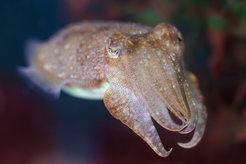Camouflage and Texture Perception in Squid
On our planet, the camouflage of cephalopods such as octopuses and cuttlefish is one of the most remarkable behaviors found in nature. This adaptation evolved in these species after they lost the outer shell of their ancestors (still present in the distant relative Nautilus) and became vulnerable to rapidly evolving predators such as fish. Over millions of years, natural selection has led them to develop tricks to alter their appearance so that they are visually unrecognizable (or barely detectable) to both prey and predators.

One reason that cephalopod camouflage is of general importance is that it reflects a process performed by all nervous systems: the segmentation of visual scenes into "texture patches". More generally, camouflage is an expression of the phenomenon of texture perception, which is also characteristic of human vision.
A second interesting reason is that cephalopod camouflage deceives us (and their natural enemies, such as fish), which means that their perception of texture must be similar to ours, even though cephalopods (mollusks in general) diverged from our lineage about 650-700 million years ago from a common worm-like ancestor with a primitive nervous system. This suggests that texture perception in cephalopods and vertebrates must have converged rather than evolved from pre-existing principles.
A third reason why camouflage is interesting is that it provides us observers with a direct measure of how animals perceive the world: we can film the skin of these animals and directly read how they perceive a visual scene. This is a unique advantage for sensory physiology.
In summary, cephalopods allow us to study a general feature of highly developed visual systems, including our own, through a behavior that occurs only in certain cephalopods: the segmentation of visual scenes into texture patches.
